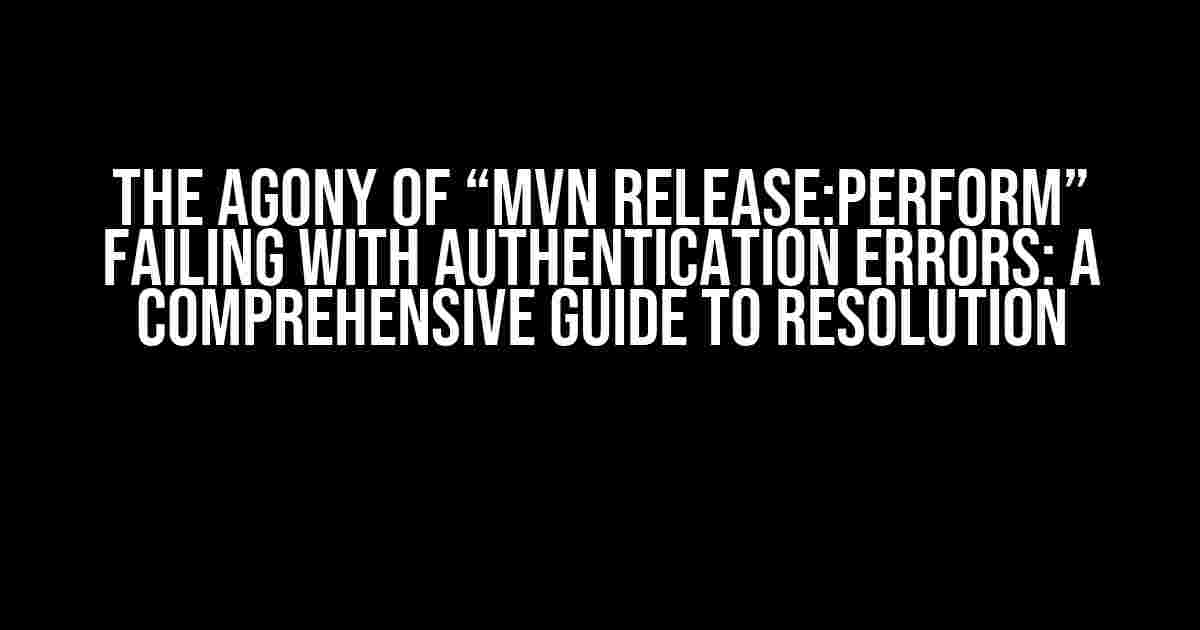Ah, the dreaded “mvn release:perform” authentication error! It’s a nightmare that has haunted many a developer, leaving them vexed and frustrated. But fear not, dear reader, for we’re about to embark on a thrilling adventure to vanquish this beast and get your Maven release process back on track.
What’s Behind the Authentication Error?
Before we dive into the solutions, let’s take a moment to understand the root cause of the problem. The “mvn release:perform” command is used to perform a release deployment of your Maven project. This includes building, testing, and uploading your project to a remote repository, such as Nexus or Artifactory. However, when Maven attempts to authenticate with the repository, it may encounter issues, resulting in the dreaded authentication error.
Common Causes of Authentication Errors
- Invalid Credentials: Typos in usernames, passwords, or incorrect credentials can lead to authentication failures.
- Repository URL Issues: Misconfigured repository URLs, SSL certificate problems, or incorrect protocol settings can cause authentication errors.
- Network Connectivity Problems: Firewalls, proxy issues, or unstable network connections can prevent Maven from reaching the repository.
- Policy or Permission Issues: Insufficient permissions, incorrect role assignments, or overly restrictive policies can block Maven’s access to the repository.
Solving the Authentication Error: A Step-by-Step Guide
Now that we’ve identified the potential causes, let’s tackle the solutions. Follow these steps to resolve the “mvn release:perform” authentication error:
Step 1: Verify Credentials and Repository URL
Double-check your credentials and repository URL to ensure they’re correct and properly configured:
<settings>
<servers>
<server>
<id>nexus-repo</id>
<username>your-username</username>
<password>your-password</password>
</server>
</servers>
</settings>Make sure to update your `settings.xml` file with the correct credentials and repository URL.
Step 2: Check Repository URL and SSL Certificate
Verify that your repository URL is correct and the SSL certificate is properly configured:
<repositories>
<repository>
<id>nexus-repo</id>
<url>https://your-nexus-repo.com/repository/maven-releases/</url>
</repository>
</repositories>Ensure that the repository URL is correct, and the SSL certificate is trusted or imported into your Maven truststore.
Step 3: Configure Proxy Settings (If Necessary)
If you’re behind a proxy, update your Maven `settings.xml` file to include proxy settings:
<proxies>
<proxy>
<active>true</active>
<protocol>http</protocol>
<host>your-proxy-host.com</host>
<port>8080</port>
<username>your-proxy-username</username>
<password>your-proxy-password</password>
</proxy>
</proxies>Adjust the proxy settings according to your organization’s requirements.
Step 4: Check Permissions and Policy Issues
Verify that your Maven user has the necessary permissions and roles to access the repository:
| Role | Permissions |
|---|---|
| Maven User | Read, Write, Deploy |
Consult with your repository administrator to ensure that your Maven user has the required permissions and roles.
Step 5: Try the “mvn release:perform” Command Again
After addressing the potential causes, retry the “mvn release:perform” command:
$ mvn release:performIf you’re still encountering issues, refer to the Maven logs for more detailed error messages.
Bonus Tips and Tricks
To avoid future authentication errors, consider the following best practices:
Use Environment Variables or External Properties Files
Instead of hardcoding credentials in your `settings.xml` file, use environment variables or external properties files to store sensitive information:
<servers>
<server>
<id>nexus-repo</id>
<username>${nexus.username}</username>
<password>${nexus.password}</password>
</server>
</servers>This approach adds an extra layer of security and flexibility to your Maven configuration.
Enable Maven Debugging
To gain more insights into the authentication process, enable Maven debugging:
$ mvn release:perform -XThis will provide you with detailed logs and error messages to help troubleshoot the issue.
Use a Maven Plugin for Repository Management
Consider using a Maven plugin, such as the nexus-staging-maven-plugin, to simplify repository management and deployment:
<plugin>
<groupId>org.sonatype.plugins</groupId>
<artifactId>nexus-staging-maven-plugin</artifactId>
<version>1.6.8</version>
<configuration>
<nexusUrl>https://your-nexus-repo.com</nexusUrl>
<serverId>nexus-repo</serverId>
</configuration>
</plugin>This plugin provides features like automated staging and deployment, making it easier to manage your repository.
Conclusion
By following these steps and tips, you should be able to resolve the “mvn release:perform” authentication error and get your Maven project released successfully. Remember to verify your credentials, repository URL, and proxy settings, and to check for permissions and policy issues. With patience and persistence, you’ll be enjoying the thrill of a smooth Maven release in no time!
We hope this comprehensive guide has helped you overcome the frustration of the “mvn release:perform” authentication error. If you have any further questions or concerns, feel free to ask in the comments below.
Frequently Asked Question
Maven release woes? Don’t worry, we’ve got you covered!
Q1: Why does mvn release:perform fail with an authentication error?
This error typically occurs when Maven is unable to authenticate with the remote repository. Check that your credentials are correct and that you have the necessary permissions to deploy to the repository.
Q2: How do I troubleshoot the authentication error?
Try running the command with the `-e` flag to enable DEBUG logging, which can provide more detailed information about the error. You can also check the Maven logs for any authentication-related errors.
Q3: What should I do if I’m using a username and password in my settings.xml?
Make sure that the username and password are correct and that the password is not encrypted. If you’re using an encrypted password, ensure that the master password is correct and that the encryption is done correctly.
Q4: Can I use Maven’s built-in support for SSH authentication?
Yes! Maven provides built-in support for SSH authentication. You can configure your Maven settings to use SSH authentication by specifying the SSH credentials in your settings.xml file.
Q5: What if I’m still stuck and none of the above solutions work?
Don’t worry! Reach out to your organization’s Maven expert or seek help from online communities such as Stack Overflow or Maven’s official forums. You can also try searching for similar issues on GitHub or other online resources.
